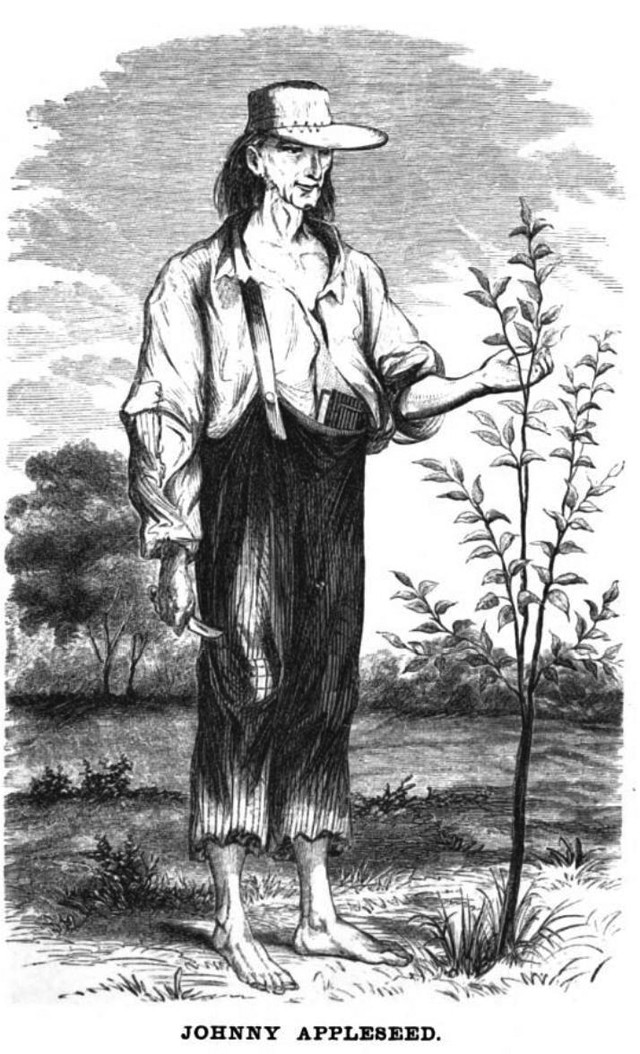
by John Copeland Thursday, August 20, 2015

Drawing of Jonathan Chapman, aka Johnny Appleseed from 1862. Credit: Public Domain.
You’ve probably heard about Johnny Appleseed, who, according to story and song, spread his apple seeds across America’s Midwest. But, unlike other figures from American folklore such as Paul Bunyan, Rip Van Winkle and Pecos Bill, Johnny Appleseed was a real man with a life far richer and more interesting than the legend.
His real name was John Chapman and he was born in Massachusetts on Sept. 26, 1774. For the time, he was considered an eccentric: He was a vegetarian and an evangelist, he traveled barefoot, and, equally out of character for the day, he showed kindness to animals and befriended the Native Americans. Chapman became a mythic figure, helping tame the wilderness by planting apple orchards.
The Johnny Appleseed legend suggests his plantings were random, but there was actually an economic basis behind where Chapman seeded. Frontier law allowed people to lay claim to wilderness land through the development of a permanent homestead, and such a claim could be established by planting 50 apple trees. Chapman realized he could plant these orchards and then sell them to incoming frontiersmen.
Trekking from Pennsylvania through Ohio, Michigan, Indiana and Illinois, Chapman cultivated his orchards and became a land baron as he traversed 260,000 square kilometers of Midwestern wilderness and prairie. One could describe him as a shrewd real estate developer.
Chapman carried a leather bag filled with apple seeds he collected from cider mills. Legend says he planted his seeds in open places in the forests, along roadways and by streams. In truth, he took great care creating his nurseries, first selecting fertile planting spots, then fencing them with brush and vines, and later returning at regular intervals to repair the fences, tend the ground and sell his trees.
The apples that grew from Chapman’s seeds were different from the apples we know today. They were small, tart “spitters,” named for what you’d likely do after taking a bite of one. Apple trees grown from seeds bear fruit that is very sour or bitter. To cultivate edible apples, you graft and clone trees known to bear tasty fruit.
Chapman knew about grafting, but as a member of the Swedenborgian Church — whose belief system explicitly forbade grafting, which was believed to cause plants to suffer — he planted his orchards from seed. It wasn’t a problem, however, because his apples weren’t being used for eating.
In 18th- and 19th-century America, apples were grown for making hard cider — an important part of frontier life. It was a safe, stable source of drink. In a time when water could be full of dangerous bacteria, cider could be imbibed without worry. Johnny Appleseed brought the means for making the alcoholic drink of choice to the frontier.
By 1806, Chapman had been nicknamed “Johnny Appleseed,” and tales of his prowess began to spread. History has bestowed us with first-hand accounts left by settlers who welcomed him into their cabins. They gave him a meal and a place to sleep in exchange for apples, apple trees and news, including stories of his own exploits. For the settlers, there was enormous entertainment value in having a guest who was a legend in his own time.
Chapman worked steadily for more than 40 years. His favorite apple was evidently the Rambo, revealed by the fact that it was found on nearly every farm in the region that this pioneer nurseryman traversed.
He died in Fort Wayne, Ind., in March 1845 at age 70, leaving an estate that included some 500 hectares. Although he lived modestly, Chapman died a wealthy man.
By the time the U.S. government outlawed alcohol in 1920, Chapman was an American folk hero. But this didn’t stop FBI agents from mercilessly tearing down his orchards to prevent bootleggers from making homemade hooch. We can thank prohibition for shifting the image of the apple to the healthy, wholesome, American-as-apple-pie fruit it is today.
The myth of Johnny Appleseed grew partly because Chapman’s respectful relationship with nature transcended that of the typical pioneer, who mostly saw the natural landscape as something to be conquered. Although he shunned civilization himself, he was a civilizing agent, working to domesticate the wilderness. He also drank, took snuff, told jokes and brought two very different kinds of consolation to people living on the frontier conditions: religion and booze.
Today, Johnny Appleseed stands apart from frontier characters like Davy Crockett and Daniel Boone, who battled both nature and Native Americans to open the West to American pioneers. Chapman’s apple trees helped transform the American frontier and pave the way for settlement. His image has evolved from pioneer planter to patron saint of horticulture, and he’s a folk hero to this day.
© 2008-2021. All rights reserved. Any copying, redistribution or retransmission of any of the contents of this service without the expressed written permission of the American Geosciences Institute is expressly prohibited. Click here for all copyright requests.